

Tips for Writing a Cover Letter That Will Stand Out

First tip on how to write a cover letter
Use fewer words to say more, tailor your cover letter to a specific job, be proud of your past accomplishments, address the hiring manager personally, use keywords from the job description, throw in numbers and examples, more ‘don’ts’ when writing a cover letter, last cover letter tip: proofread your work.
In this age of digital recruiting, do you really need to write something to accompany your resume or job application? Is writing a cover letter really important? Here’s a tip for you: The short answer is yes!
Yet, far too often, job seekers treat the process of writing a cover letter as an afterthought to submitting a resume. Or they don’t bother to write one at all.
Your cover letter is your introduction to a prospective employer. It’s also an opportunity to make a great first impression and to showcase why you’d make a great hire. So don’t squander it.
These days, it’s unlikely a cover letter, like your resume , would be something you’d print and mail to a hiring manager. In fact, it may not be a letter at all. The savviest job seekers will include the modern equivalent of a targeted cover letter in the body of an email message or an online job application.
Take a look at these cover letter tips that will convince hiring managers and HR professionals to call you for an interview.
The first cover letter tip is straight to the point: Don’t rehash your resume. Your words should do more than restate salient details from what’s already in your resume. The cover letter is where you should promote yourself, describe your ambition and express your enthusiasm for a new role and company in a way that is distinct from your resume.
Check out this brief checklist of important functions of a targeted cover letter:
- A cover letter specifically relates your skills and experience to the job description and requested qualifications.
- It explains why you would love to have the job in question.
- It shows you’ve done research on the company, by commenting on its mission or key leadership.
- It finishes with a call to action that invites the hiring manager to follow up with you regarding the job opportunity.
The barrage of information coming at all of us today has created attention spans that are shorter than ever before. Cover letters are no exception. Managers are often inundated with applications, so economy of words matters.
In fact, keep it brief with a three-paragraph format, using each paragraph to focus on an aspect of your application.
- Start with an attention-grabbing introduction that expresses your enthusiasm about the position and the company. If you have a referral, drop their name here.
- This is your sales pitch where you address your top skills, accomplishments and attributes, and explain why your qualifications relate to this particular role or company.
- Finally, restate briefly how you can add value, thank the hiring manager for their consideration and initiate the next step by saying you’d like to follow up with a call or an interview.
For more tips related to that last paragraph, read about how to write a cover letter closing .
Don’t use a one-size-fits-all cover letter template for all the positions you apply for. If you do, you’re missing the point: Only a letter that’s targeted to the job at hand will make a positive impression.
Write a cover letter employers can’t ignore by tying it to the elements of the job that match your unique skills and experience. What are they asking for that you’re especially good at? What would make your contribution unique? Those are the points to stress when writing a cover letter.
Just as important, gather facts and figures that support your claims with details. For example, if you’re applying for a managerial role, mention the size of teams and budgets you’ve managed. If it’s a sales role, describe specific sales goals you’ve achieved.
In addition to highlighting your talents, you can further personalize your cover letter by demonstrating your familiarity with the specific industry, employer and type of position.
Companies want confident employees who love their work. They know these are the people who tend to perform better, serve as stronger team members and have greater potential to grow along with the business.
Draw attention to specific examples of projects you’ve worked on that make you an ideal candidate, and don’t hesitate to brag a little about your most pertinent achievements. Consider adding a sentence or two — or even a bullet list, as long as you’re not duplicating your resume — of key achievements backed up with quantitative data. Did you increase revenue by identifying tax savings worth $50,000 a year, win six design awards, quadruple the company’s social media following? Here’s the place to mention it.
Upload your resume to be considered for jobs that match.
How would you feel if you got an email addressed, To Whom It May Concern? Just as you personalize your resume to the role, you should also address the cover letter to the person actually hiring for the position, as opposed to Dear Employer. If it’s not spelled out in the job posting and you can’t find it on LinkedIn, be proactive and call the organization’s main phone number and ask for the name and title of the hiring manager.
If you’re still in school or just out, your career services office may be able to help you identify the right contact at a company.
Many employers use resume-filtering software that scans for keywords and evaluates how closely resumes and cover letters match the preferred skills and experience. That means your cover letter should incorporate key phrases you’ve identified in the job description — if they honestly match with your background and strengths.
During the writing process, carefully review the job ad for the type of degree required, the number of years’ experience needed, and desired software skills, organization and communication abilities, and project management background.
If you want to know how to write a cover letter that stands out, show how you’ve had a measurable impact on an organization. Did you bring in new clients, make a process more efficient, spearhead some campaigns? Provide specific numbers, percentages to show growth, or a range or estimate to quantify results.
Offering examples can also help you illustrate what you’ve achieved or elaborate on the specifics. Show, don’t tell, whenever possible when you describe what you’ve done and what you can bring to your next position.
- Don’t overshare — Showing some personality is generally fine, but keep the focus on your career. Stick to pertinent facts and omit personal details unrelated to your ability to perform the job.
- Don’t go overboard with self-celebration — Employers expect job candidates to use the cover letter to toot their own horn. (That’s the whole point, right?) Instead of bragging about being the “world’s best UX designer” or a “marketing superhero,” job seekers should provide concrete information that conveys value and impact. Bold statements are OK, as long as you back them up with facts.
- Don’t make demands — Zero in on what you can do for the employer, not what you hope to gain from the company. It’s both presumptuous and off-putting to cite salary demands before you’ve even landed a phone or video interview . The same goes for bringing up the perks and benefits you expect.
- Don’t fail to follow directions — Employers often provide specific instructions in the job ad, such as submitting your resume and cover letter in a certain file format or referencing the job title or requisition number. Before you upload your letter or hit the send button, reread the job posting to make sure you’ve done everything the employer asked so you don’t raise red flags.
Last, but decidedly not least in these suggestions and tips for how to write a cover letter, proofread your work. This is not just a cover letter tip, of course, but also applies to resumes and other important correspondence and documents. After you’ve made a strong argument for your candidacy and given your letter a final polish, ask a friend or family member with a strong eye for typos and good grammar, punctuation and spelling skills to review it. Include a copy of the job posting to make sure you’ve hit all the right points.
Then do it. Press send!


CVs & Résumés
How to write a cover..., how to write a cover letter: 20 essential tips (+3 examples).
The document that gets you noticed by employers.
- Updated 27 Oct 2023
- 14 min read
Chris Leitch
Editor-in-Chief & Résumé Expert
Reviewed by Electra Michaelidou

Cover letters are the bane of every jobseeker’s existence. But they’re a necessary evil.
Indeed, most hiring managers will use your cover letter to evaluate your candidacy and decide on whether reading your résumé is worth their time , never mind inviting you to an interview.
That’s why it’s so important to spend time and careful thought in writing the least generic and most compelling cover letter you can.
Not sure how to write a letter that grabs the hiring manager’s attention?
In this article, you’ll find a curated collection of 20 tips that will walk you through the entire process, from start to finish — plus examples to inspire you and a free template to ensure job search success in 2024 .
Getting started
Before you put pen to paper (or hand to keyboard), you’ll first need to do some prep work for your cover letter:
1. Understand the purpose of a cover letter
Writing a cover letter is so much more than simply a way to express your interest in an open position. It’s a way to effectively market yourself as the ideal candidate for said position.
Essentially, your letter should do four things:
- Relate your skills, experience and qualifications to the target job.
- Explain why you want the job in question.
- Demonstrate your interest in the company.
- Invite the reader to follow up with you regarding the job opportunity.
Keeping all this in the back of your mind as you set out to write your letter can help you write a better one.
2. Review the job description
It’s time to go back to the job description of the position you want to apply for, and carefully read it — and read it again — to really understand what the employer is looking for in the ideal candidate.
As you read through the description, make note of any important keywords and phrases , as well as any special instructions. All this will come in handy during the writing stage, which we’ll get to shortly.
3. Research the company
Find out as much as you can about the company you’re applying to. Check out their website (paying special attention to their mission, values and culture), read up on company news and announcements, and go over employee reviews.
The more you know about your potential employer, the better you can personalize your letter to them. For example, if they’re planning to expand operations to Asia, you could highlight your fluency in Mandarin or Hindi , or how you previously worked in Japan for five years and have an extensive list of useful industry contacts.
4. Identify your unique selling point
Everyone has a unique selling point. It could be being fluent in seven languages, having a knack for turning failing companies around, or being the winner of a highly prestigious industry award.
Take the time to identify your own USP — essentially what makes you unique among your competition — by assessing your skills , experiences, qualifications and accomplishments. This should then be the focus of your letter.
Writing your cover letter
Now it’s time for the actual writing part. Just keep the following tips in mind:
5. Focus on what you bring to the table
One of the biggest cover letter mistakes that you can make is making it all about you — think: “I am applying for this job, as I believe it will help me develop my skill set and expand my knowledge.”
Employers don’t want to feel like they’re a steppingstone onto something bigger and better. They want to know what you can do for them , not what they can do for you . So, focus your letter around how your past experiences and achievements can help you contribute to their company’s success.
6. Incorporate keywords
Consulting the list of keywords and phrases that you identified when reviewing the job description, figure out how you can naturally incorporate them into your letter .
For example, if “in-depth knowledge of SEO” is listed among the position’s requirements, you could work the exact phrase into your letter, like so: “With 8 years of experience in copyediting for leading digital publications, I have in-depth knowledge of SEO and social media marketing .”
That said, don’t go overboard. Only do this for the most relevant and important keywords, and only where it makes sense to do so.
7. Don’t apologize for skills you don’t have
While you should, ideally, be applying for jobs that you’re qualified for, you (or anyone else) will never meet 100% of the position’s requirements — and that’s okay. What’s not okay is apologizing for your shortfalls.
When you bring attention to the skills or qualifications that you lack, you’re setting yourself up for failure, as your lack of confidence will rub off on the hiring manager . Instead, direct their attention to your strengths.
8. Use numbers and metrics
Don’t just tell the hiring manager that you’re good at something — show them, too. A simple trick to achieve this is to quantify your achievements with numbers and metrics, as doing so provides concrete evidence of your impact and results in past jobs.
For example, instead of simply saying that you have a “track record of increasing revenue”, mention how much revenue increased by because of your efforts — like so:
As the Vice President of Sales at Company ABC, I increased annual revenue by 45% in just one year, doubling our client base and establishing strong relationships with key stakeholders.
9. Don’t rehash your résumé
Your cover letter is meant to complement — not replicate — your résumé.
While it should touch upon the content of your résumé (that is: your experiences, skills and accomplishments), your letter should “zoom in” on the most salient points of your résumé and talk about your experiences in a way that you otherwise couldn’t highlight there, given the limited space you have.
Still, make sure that the information you’re touching upon in your letter has already been included in your résumé — don’t introduce brand-new skills, achievements and experiences.
10. Be concise
At the heart of impactful writing is conciseness. This helps improve clarity, keep your reader engaged and even enhance your credibility.
Keep your cover letter to one full page at most — and half a page at least — and aim for a total of 250–400 words. Also, use short sentences (no more than 25 words), limit paragraphs to 3–5 lines, and consider using bullet points to break down longer paragraphs into easily digestible chunks.
11. Use active voice
The active voice (eg: “Zombies ate Karen”) is far more direct, impactful and compelling than the passive voice (eg: “Karen was eaten by zombies”). It also makes you sound more confident and professional.
Of course, the passive voice sometimes works better than the active voice (such as when you want to emphasize the action over the subject), but try to steer clear of it as much as you can. You can do this by watching out for “by” phrases and “to be” verbs (“be”, “is”, “being”, “been”, etc).
12. Get the tone right
It’s not just about what you say in your cover letter; it’s also about how you say it.
It’s a good idea to match your writing style to that of the company . If their website’s tone of voice is formal, then adopt the same tone in your letter. If they’re quite laidback, though, then use a more upbeat and friendly tone.
As a general rule of thumb, keep it professional — but try to work in a bit of your own personality (without going overboard).
13. Use positive language
In your cover letter, positive language can increase optimism in the reader of you and portray you as a credible and respectable applicant .
Where possible, use “I am” and “I have” phrases (which demonstrate confidence), as opposed to “I feel” and “I believe” phrases (which are subjective and imply uncertainty in your own abilities). Likewise, eliminate weak words and phrases like “some knowledge” and “fairly experienced”, and generally try to use language that shows agreement, flexibility or incentive.
14. Follow any special instructions
Some job descriptions include special requests for cover letters, such as answering specific questions, listing salary requirements (which is rare but not unheard of) or using a particular file type. It is beyond imperative that you follow any such instructions precisely .
If you don’t, the hiring manager will inevitably assume that you’re either a) lazy or b) unable to follow basic instructions — either way, it will land your job application in the rejection pile .
15. Don’t overuse “I”
While your letter should use a first-person perspective, you need to be careful that it doesn’t end up sounding like your autobiography and creating the perception that you’re self-centered .
As such, it’s a good idea to minimize the use of personal pronouns like “I” and “my” where possible. If you can, rework sentences that contain instances of “I”, especially at the beginning — without, of course, sacrificing proper grammar.
16. Speak to the reader
When you speak to the reader, and not about them, you can better connect with them . As a result, they’ll be more inclined to shortlist you, as you’ve already got some rapport going.
Do this by addressing the hiring manager by name in your letter’s greeting, highlighting the common ground you found during your research, and incorporating personal pronouns like “you” and “your” (where it makes sense to do so).
As a lifelong fan of Company ABC, I was excited to learn that you’re currently looking for a Junior Accountant to join your San Francisco-based team.
17. Use plain English
You may be applying for a highly technical job, but your application will likely (at least at first) be read by a recruiter or HR manager who isn’t at all familiar with terminology frequently used in your field.
As such, it’s best to use plain English that everyone can understand — regardless their job title or even language proficiency — and to keep industry jargon to an absolute minimum .
Testing your cover letter
You’ve finished writing your cover letter and you’re ready to submit it, but wait — don’t hit the “Apply” button just yet:
18. Proofread
Always make the time to proofread your cover letter ( and résumé! ) before sending it off.
Ideally, you should take a couple of hours away from your letter , allowing yourself to recharge your batteries and come back to it with a fresh pair of eyes.
Try different proofreading techniques , like reading your letter backwards, reading it aloud, and focusing on one issue at a time (capitalization, verb tenses, spelling, punctuation, and so on).
19. Ask for feedback
As you’re the one writing your cover letter, it’s sometimes difficult to be unbiased when reviewing your own work . After all, you know what you’re trying to say — which makes it easier to miss mistakes in terms of structure, flow and grammar.
For this reason, it’s a good idea to ask friends, relatives, teachers or, even better, a professional résumé writer for their feedback. Email them a copy of your letter, including a link to the job you’re applying for and a list of things you particularly want their input on.
20. Email your letter to yourself
Finally, it’s important to make sure your document works properly when opened . You can do this by sending a test email (with your letter attached) to yourself and opening it on a different computer.
This is a great way to check your letter’s formatting, and fonts especially — indeed, the font you’ve chosen may not be supported by the hiring manager’s operating system. This will result in a replacement font being displayed, which could potentially impact your cover letter’s overall look and feel for the worse.
Check out our video with our best cover letter tips:
Cover letter template
Our free, ATS-optimized cover letter template is both editable and easy to use, and comes complete with helpful suggestions and practical tips to guide you in crafting your own job-winning letter.

Download the template by subscribing below:
Cover letter examples
Need some writing inspiration? We’ve crafted three cover letter samples, each tailored to a specific situation, to help you get started — all based on our collection of professionally designed premium templates.
1. Changing jobs (and employers)
If you’ve decided it’s time to move on to greener pastures , your cover letter should highlight what you can do (and that you do it well) and how your past success and results can benefit the company you’re applying to. Consider this cover letter example:
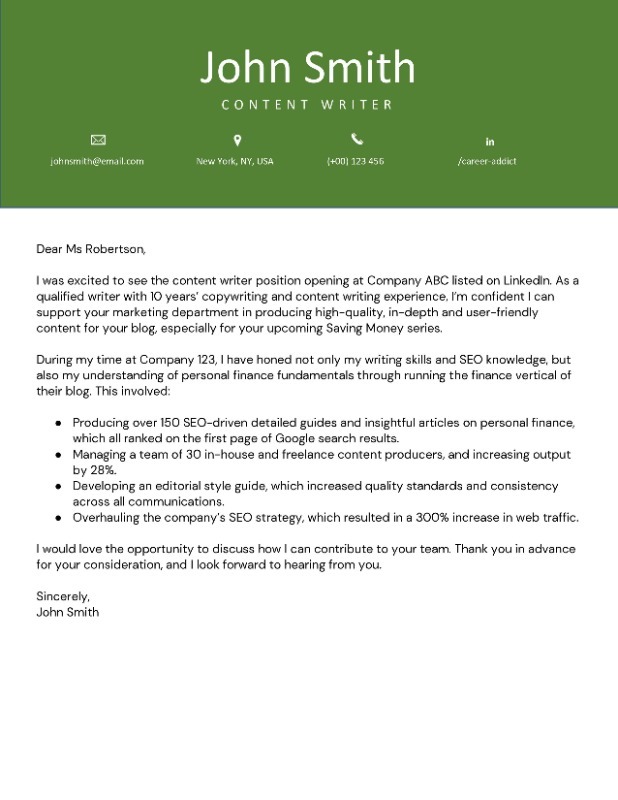
Get the Active template
2. Applying for an internal position
If you’re eyeing an internal position that has recently opened, you’re at an advantage as you know more about the company’s internal structure, culture and priorities than you would if you were applying to a different company. For internal position cover letters, it’s always a good idea to name-drop a recommendation or referral, like in this sample:
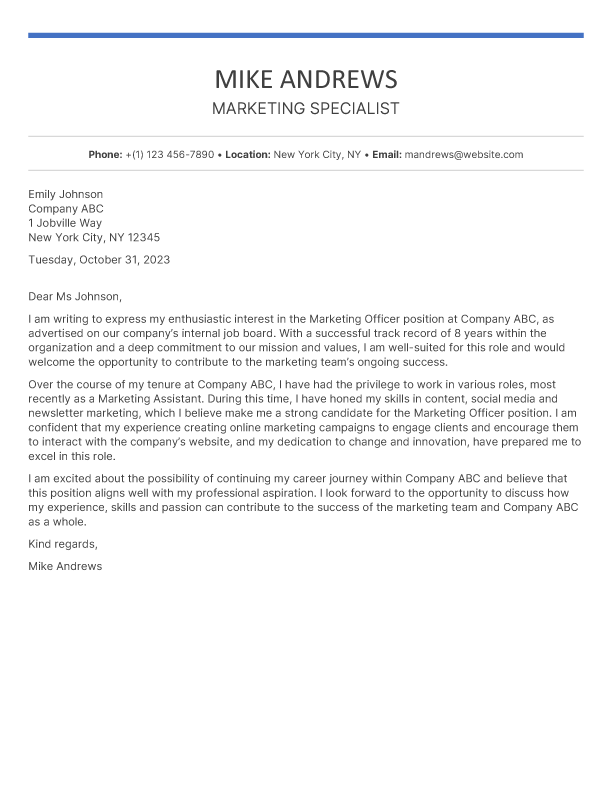
Get the ATS-Friendly Template

3. Applying for a scholarship
Cover letters aren’t strictly reserved for applying for a job or an internship. They can also be used for scholarship, grant and even college applications, where you should highlight your dedication, passion and goals. Consider this sample scholarship cover letter:

Get the Savvy template
Cover letter FAQs
If you still have questions about cover letters, fret not: we’ve got the answers.
What is a cover letter?
A cover letter is a one-page document that you submit as part of your job application (alongside your résumé). It’s, essentially, a piece of persuasive writing that introduces yourself to potential employers and conveys why you’re a great candidate for the position.
Do I even need one?
Yes, cover letters are absolutely necessary . Hiring managers expect you to include a cover letter in your job application , and if they can’t find one attached, they’ll likely assume that you don’t really care about the job — which could mean instant rejection. The only time you should ever skip the cover letter is when the job description specifically requests you to (which is rarely the case).
How should I structure my letter?
Your cover letter should consist of three main parts: an opening paragraph (introducing yourself and why you’re applying), the middle paragraphs (highlighting why you’re a great fit for the job) and a closing paragraph (expressing gratitude and highlighting a call to action). Make sure to also include a professional greeting and a complimentary close.
How should I design my letter?
Your cover letter should complement your résumé’s design and overall look . This means using the same fonts and colors, and adopting the same formatting across both documents (and any other supplemental documents, for that matter). This will effectively help you create a consistent personal brand .
How should I submit it?
This depends on the employer’s preferred method. You’ll typically find this information at the end of the job description, where you’ll be asked to either complete an online form or send an email. In the case of the latter, make sure to write a short, descriptive subject line like “John Smith — Application for Junior Accountant Position”.
Key takeaways
While your résumé is what gets you the interview , it’s your cover letter that opens the door in the first place. But a cover letter takes careful thought and effort — get it wrong, and that door is swiftly closed in your face.
Using the tips and examples we explored in this article, you’ll hopefully be able craft a cover letter that not only keeps said door open, but that also gets you through it .
To sum up, here’s what we learned about writing a strong cover letter:
- Do some prep work. This includes reviewing the job description and identifying your USP, which will be helpful when you get round to writing your cover letter.
- Be strategic. Focus on how you can contribute to the company’s success, incorporate relevant keywords, use numbers and examples, and follow any special instructions.
- Review examples for inspiration . But don’t copy/paste content you find online; use your own words to tell your story and make your letter yours .
- Add the finishing touches. Proofread your cover letter before sending it out, and ask a trusted friend to look over it too.
Got a question? Let us know in the comments section below!
Originally published on June 28, 2017.
Cover Letters
Finding a Job
Job Applications
- Skip to Content
- Skip to Sidebar
- Skip to Footer
Resume Genius
The World's Smartest Resume Builder
Monday to Friday, 8AM – 12AM (Midnight) and Saturdays and Sundays, 10AM – 6PM EDT (866) 215-9048
Blog Cover Letter Help How to Write a Cover Letter
How to Write a Cover Letter (With Examples and Writing Tips)
Picture this: you’ve already made a resume that highlights your experience and you’re about to submit a job application, but you see “cover letter required.”

As featured in *
1. List your contact details
2. Greet the hiring manager
3. Write an effective opening paragraph
4. Explain why you're qualified
5. Finish with a concise closing paragraph
Tips for writing an effective cover letter
Real world cover letter example
Additional cover letter examples
Frequently asked questions about cover letters
Cover letters are necessary to make a strong first impression on employers. But how do you write one that stands out?
In this guide, we’ll walk you through the process of writing an effective cover letter that will catch any hiring manager’s attention and increase your chances of landing an interview.
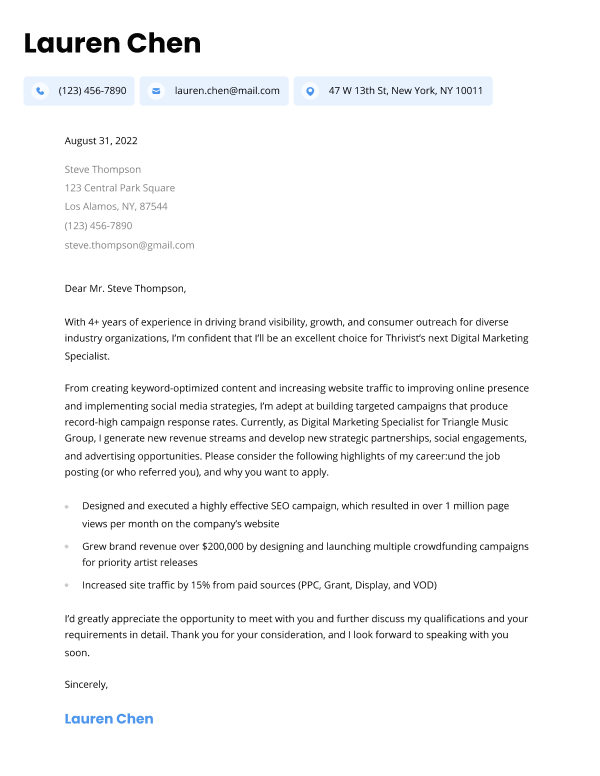
Our free-to-use cover letter builder can make you a cover letter in as little as 5 minutes. Just pick the template you want, and our software will format everything for you.
1. List your contact details in the header
Your cover letter’s header should include your name and contact information so the hiring manager can easily reach out to you if they’re interested in interviewing you. Make sure the following information is prominently displayed at the top of your cover letter:
- Email address
- Phone number
- City and state (optional)
- Linkedin profile (optional)
- Portfolio or website (optional)
- Pronouns (optional)
After your header, include the date and the company contact information in this format:
Name or job title of the person or team you’re writing to Company name Company’s street address Company’s phone number Hiring manager’s email address
Next, address your cover letter to the hiring manager — by name if possible. This personal touch shows that you’ve done your research and are genuinely interested in the position.
If you can’t find the hiring manager’s name, use a professional cover letter salutation such as “Dear Hiring Manager” or “Dear [Department Name] Team.”
Avoid outdated or overly formal greetings like “ To Whom It May Concern ” or “ Dear Sir or Madam ,” as these can make your letter feel impersonal and old-fashioned.
Cover letter greetings
Dear Jane Smith, Dear Ms. Smith, Dear [Department] Team, Dear [Company Name] Recruiter, Dear [Company Name] Hiring Team,
3. Write an opening paragraph that hooks the reader
Your opening paragraph is your chance to capture the reader’s attention and make them want to continue reading. Start your cover letter by expressing your enthusiasm for the position and the company.
Briefly mention how you learned about the job opening and why you’re excited about it. You can also use this paragraph to highlight a key achievement or skill that makes you an ideal candidate.
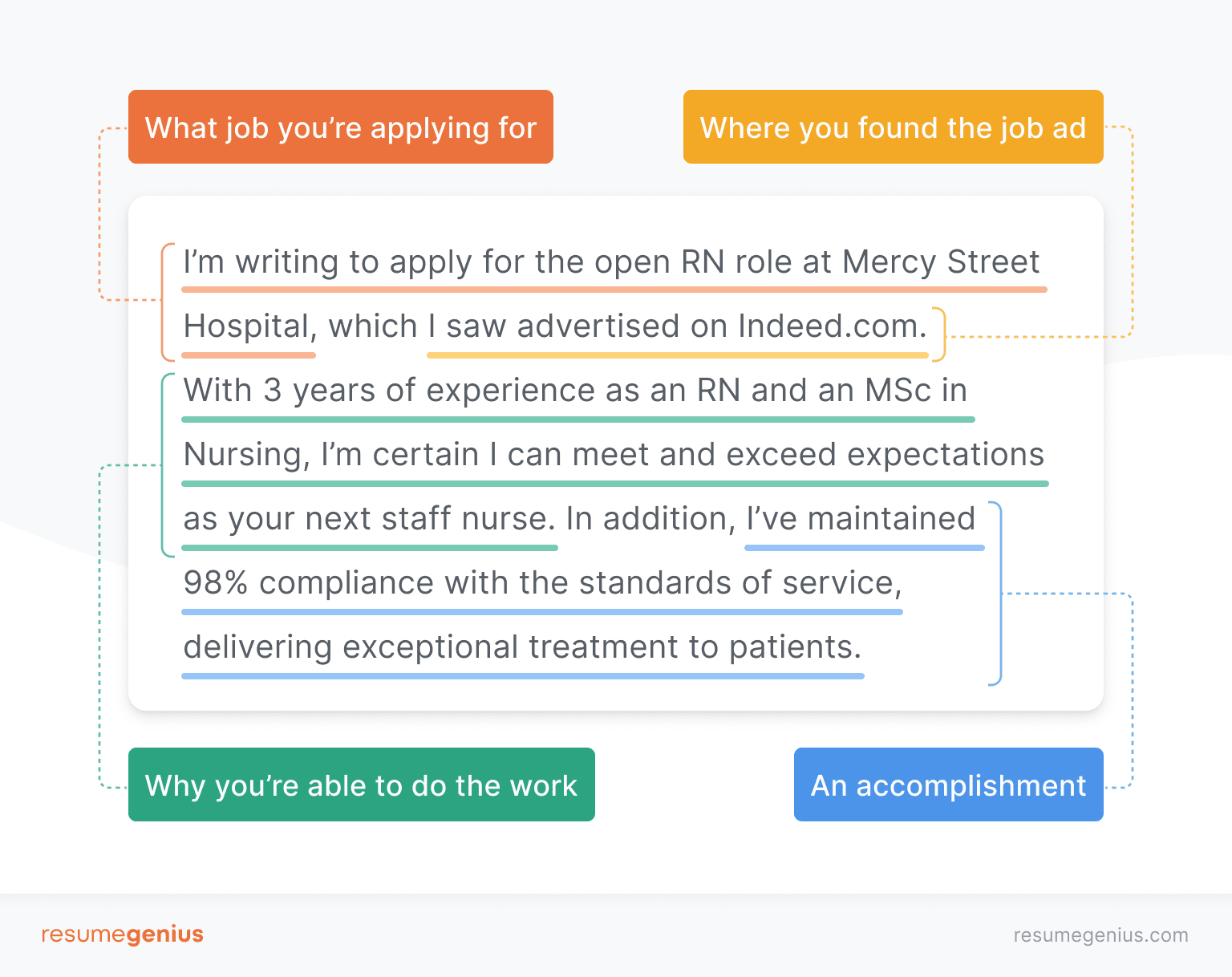
4. Explain why you’re qualified in your body paragraph(s)
Your body paragraphs should convince employers that you’re the right person for the job. Use this opportunity to market yourself by discussing your relevant work experience, skills, achievements, and enthusiasm for the job.
First body paragraph: Make a clear connection between your qualifications and the requirements of the job. Carefully review the job description and identify the skills and experiences the employer is looking for.
Second & third body paragraphs: In the following paragraph(s), demonstrate how your background aligns with these needs. Provide specific examples of your accomplishments and how they relate to the position you’re applying for.
This approach shows that you’ve done your research and are genuinely interested in adding value to the company, not just securing a job for yourself.
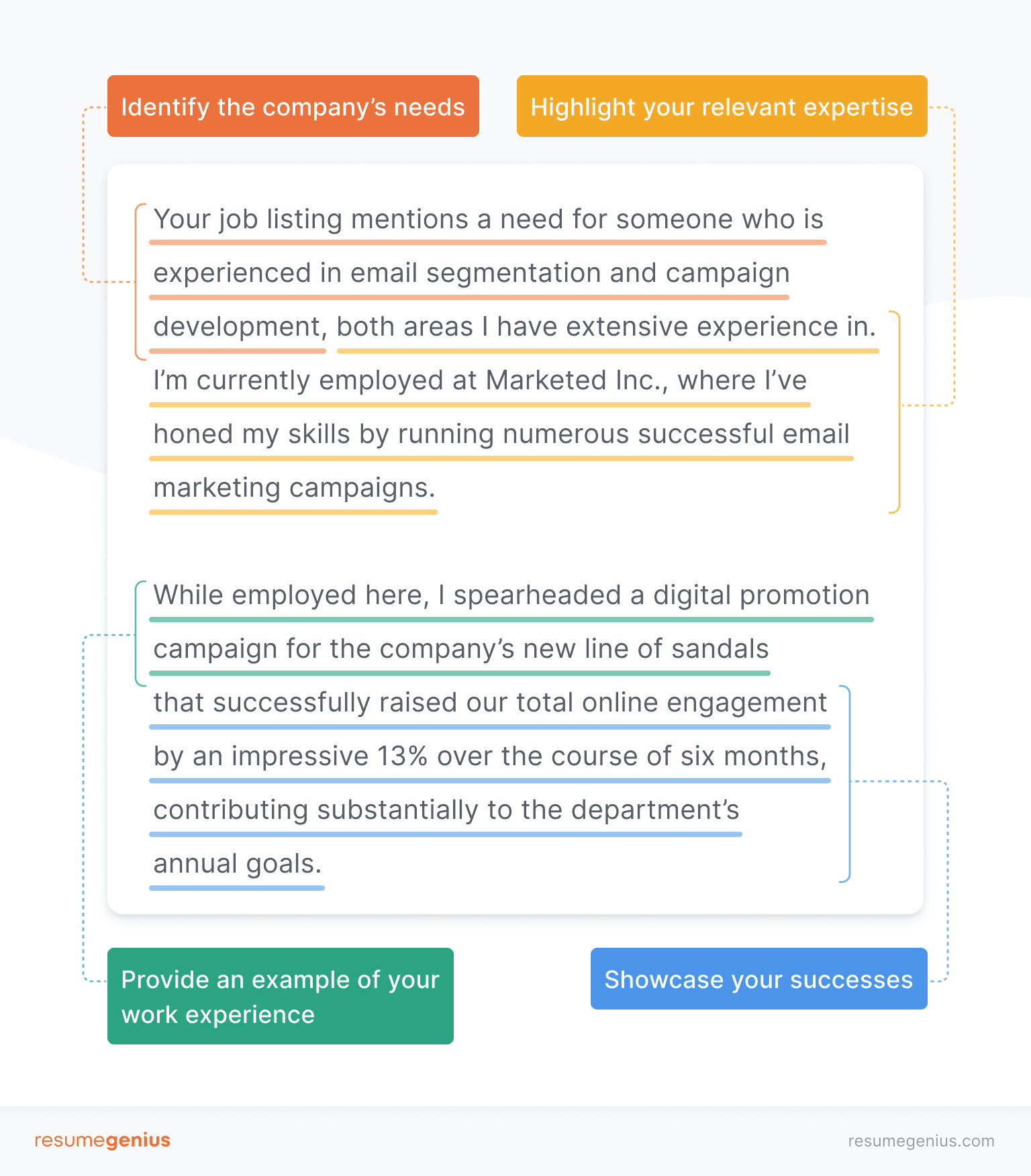
5. Finish with a concise closing paragraph and sign-off
The final paragraph is the “call to action” portion of your cover letter. When ending your cover letter , be polite and confident, and continue to market yourself as the best candidate for the job.
First, restate your excitement about the job opportunity. Then, encourage the hiring manager to interview you (remember to mention when you’re available) and thank them for their time:
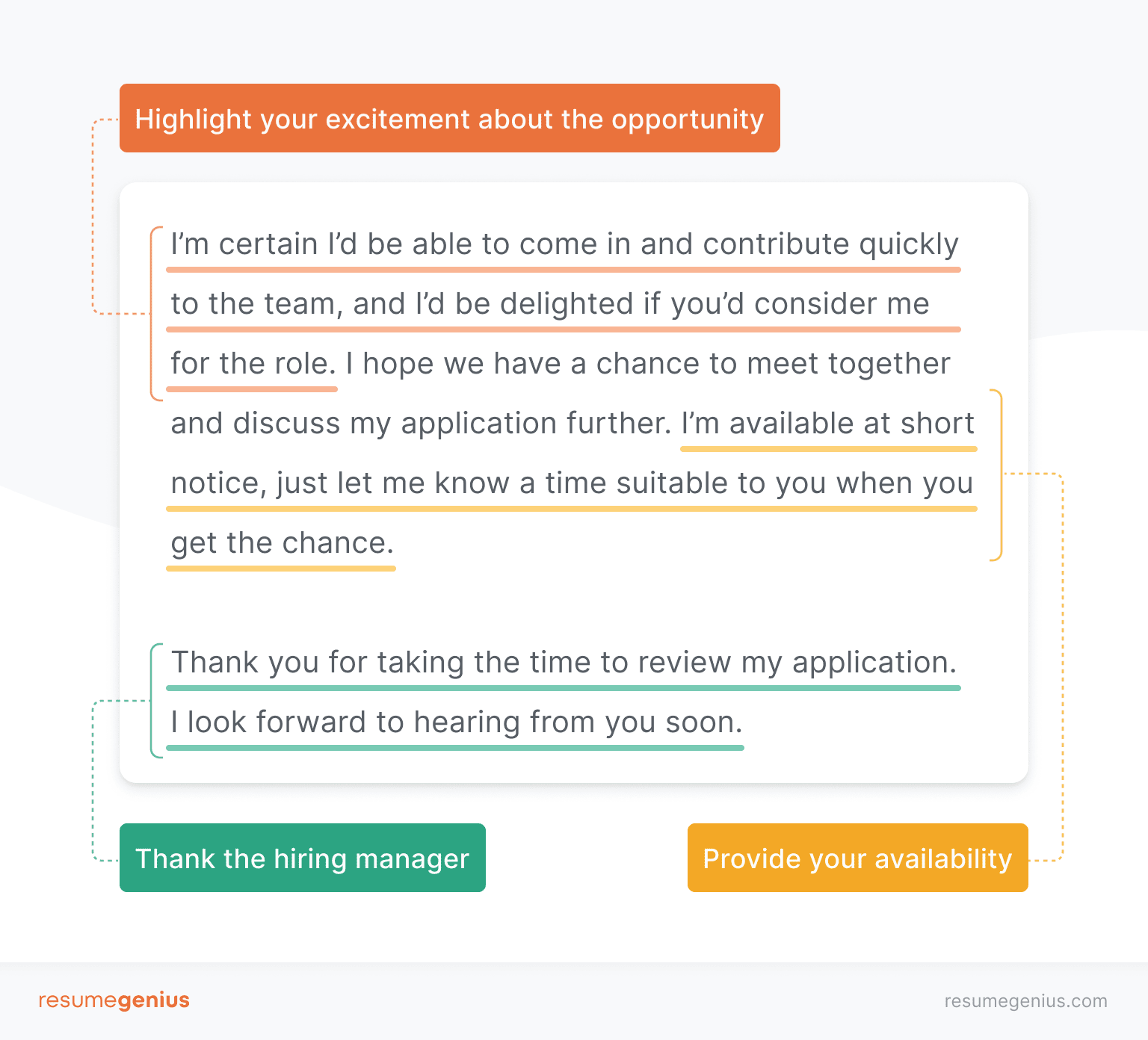
Finally, wrap up your cover letter with a professional closing salutation. The standard closing is “Sincerely,” but here are some more options:
Cover letter closings
Best wishes, Cordially, Respectfully, Kind regards, Best regards,
Then, add two line breaks below the salutation and type your full name.
For some professional (but optional) flair, sign your cover letter either with a scan of your signature or by using software like DocuSign .
Here are some additional tips to help you create the best cover letter possible:
Research the company
A little research goes a long way toward showing employers that you’re committed and genuinely interested in the role.
Take the time to thoroughly research the company you’re applying to. Visit their website, read recent news articles, and familiarize yourself with their products, services, and company culture.
Then, in your cover letter, mention specific aspects of the company that appeal to you and explain how your skills and experiences align with their mission and values.
Here are some company-related tidbits you can mention:
- Founding or origin story
- Reputation and position in the industry
- Notable successes or growth
- Measurable impact
- Future goals
- Challenges to overcome
Don’t forget to tie in why you find their mission motivating or how you can contribute. Here’s an example:
I’m inspired by EcoPower Solutions’ impressive track record in advancing sustainable energy, shown by the remarkable reduction of carbon emissions by 15% over the past year. Your dedication to environmental stewardship aligns seamlessly with my passion for clean energy, and I’m enthusiastic about contributing to the company’s future impact. My experience in implementing energy-efficient solutions that led to a 20% increase in operational efficiency perfectly complements your commitment to driving positive environmental change.
Tailor it to the job
Avoid using a generic cover letter for all of your applications. Instead, tailor each cover letter to the specific job and company you’re applying to. Use the job description as a guide, addressing the key requirements and qualifications mentioned.
Show how your skills and experiences directly relate to what the employer is looking for. This approach allows you to strategically incorporate relevant keywords to use in your cover letter and demonstrates your genuine interest in the position, making it more likely that you’ll stand out from other applicants.
Here’s a job ad with keywords highlighted:
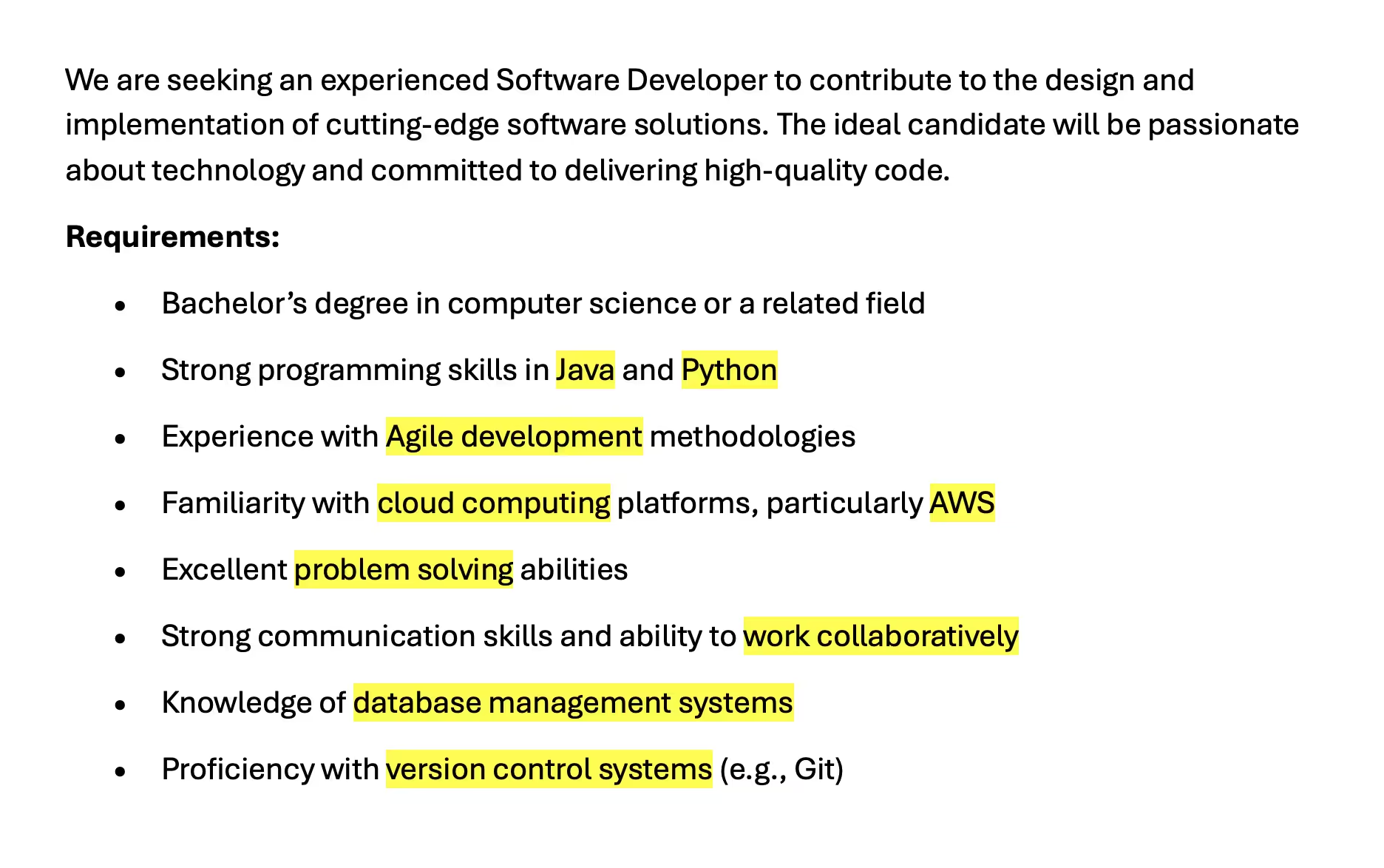
And here’s how one candidate worked those keywords into their cover letter:
As an experienced software developer with over five years in the industry, I’ve cultivated a diverse skill set that aligns perfectly with your requirements. My programming skills span multiple languages, with particular expertise in object-oriented development using Java and scripting with Python . My proficiency in Agile development methodologies has enabled me to adapt swiftly to evolving project needs, consistently delivering high-quality software on schedule. I’ve extensively worked with cloud computing platforms, especially AWS , leveraging these technologies to architect scalable and efficient applications. Throughout my career, my strong problem solving skills and capacity to work collaboratively have been key to my success, empowering me to tackle complex challenges and make significant contributions to team projects. Furthermore, my in-depth knowledge of database management and version control systems will allow me to seamlessly integrate into your development workflow, making meaningful contributions from day one.
Simplify your writing
Aim for clarity and simplicity in your writing. Use concise, straightforward language to convey your enthusiasm for the role. Avoid:
- Jargon or overly complex words (unless it’s specific to the industry and necessary for the position)
- Overused buzzwords and phrases like “dynamic,” “think outside the box,” and “go-getter”
- Vague or generic statements
Break up long sentences and paragraphs to improve readability. Remember, hiring managers often skim cover letters, so make it easy for them to quickly grasp your key qualifications and enthusiasm for the role.
Here’s a comparison between a straightforward writing style and an overly formal one:
Excited and professional
I’m thrilled to apply for the customer service position at [Company Name]. Having been a customer service representative for 5+ years at Walmart, I’m confident I can quickly apply my experience using Zendesk and Salesforce to make a positive impact on [Company Name]’s bottom line.
It is with great interest that I apply for the open customer service position posted by your company on Indeed. I possess the requisite skill set to ably perform the customer service duties described in the job requirements.
Keep it concise
Keep your cover letter’s length to about 250–400 words, or roughly one page.
Focus on your most relevant skills and experiences, and avoid repeating information that’s already in your resume. A concise, well-written cover letter demonstrates your ability to communicate effectively and respect the reader’s time.
Check your formatting
Proper cover letter format ensures that your application looks professional. A well-written cover letter is normally:
- 200–400 words ( short cover letters are easier to skim)
- Single-spaced
- US Letter (USA) or A4 (elsewhere) page size
- Left-aligned (except for your name and contact details, which can be centered)
Take a look at the checklist below before you submit your application to make sure your cover letter is formatted correctly:
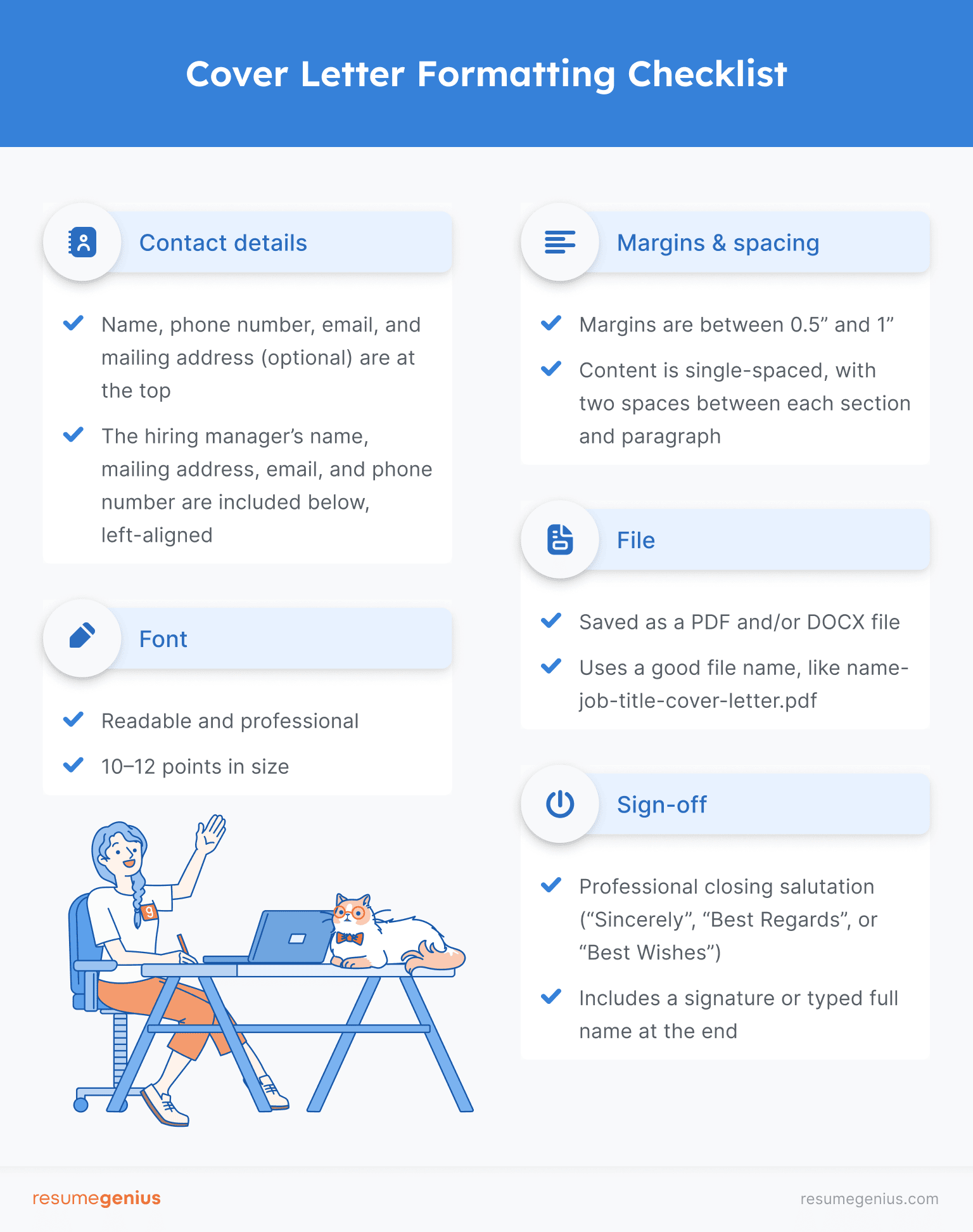
Proofread carefully
Typos and grammatical errors in your cover letter will leave a negative impression on employers.
Here are two quick tricks professional editors use to catch mistakes:
- Read your writing out loud: Reading your letter aloud forces you to consider every word, sentence, paragraph, and punctuation mark. Plus, you’ll more easily notice hard-to-read sentences, and can then simplify them.
- Change the font: A new font forces your brain to process something that seems new. Switching your cover letter’s font can help you notice mistakes you’d otherwise miss.
After you’ve read your cover letter out loud, have someone else read it over. They can provide helpful feedback and (hopefully) notice any small grammar and spelling errors you missed.
Use online tools to save time
If you’re short on time, there are several powerful cover letter builders online that you can try out. In this video, we’ll walk you through our own cover letter generator , so you can create your own in a few quick steps.
AI tools can help identify keywords to include in your cover letter. Check out our list of the best AI cover letter generators to learn more.
Cover letter example that successfully landed our content manager his job
When you’re trying to figure out how you want to write your cover letter, sometimes what’s most helpful is seeing an example that actually worked .
Here’s a cover letter our very own content manager , Conrad Benz , submitted to land his first role at Resume Genius:
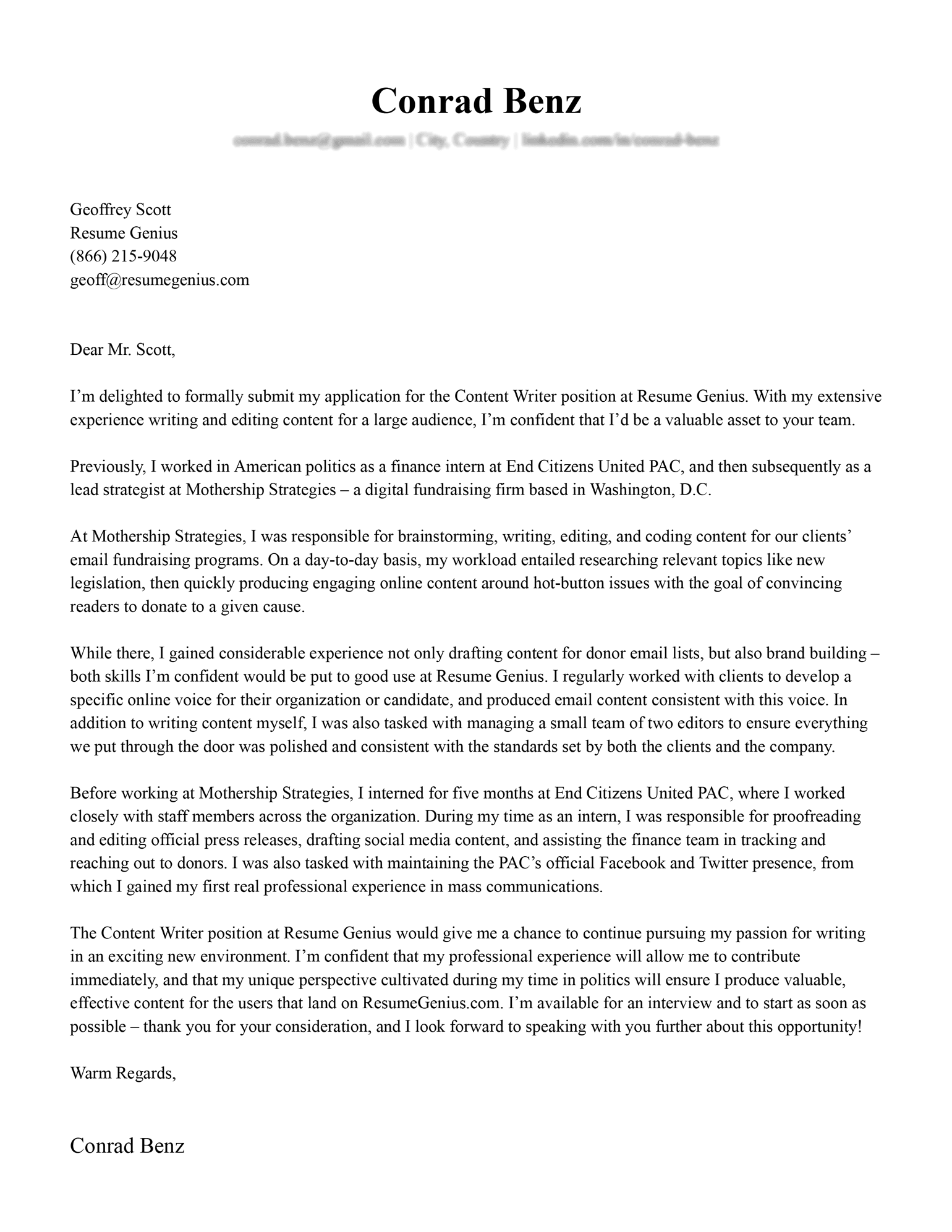
Geoff Scott , Hiring Manager at Resume Genius, provided several reasons he found Conrad’s cover letter effective:
Conrad immediately touches upon his relevant experience in the first paragraph, which makes me want to continue reading. It’s important to note that he claims to have extensive experience writing and editing, and also proves his ability to string sentences together coherently, which I appreciate. I like that Conrad focuses first on his most relevant experience, because it makes a more compelling case for him as a candidate. In the closing paragraph, Conrad’s statement of interest in pursuing his passion for writing holds more weight because he’s already used the preceding paragraphs to establish his experience effectively.
In his cover letter, Conrad did an excellent job of describing how his past experiences and the skills he developed translated to the Content Writer position, what interested him about the role, and the value he would add to the team.
However, if we were to suggest one area for improvement in retrospect – it would be to include some quantified achievements that demonstrate the scope of Conrad’s experience and maximize the impact of his cover letter.
Want to see some more cover letter examples ? Check out the industry-specific examples below:
Office Manager Cover Letter
Retail Sales Associate Cover Letter
Video Editor Cover Letter
Engineering Cover Letter Example
Bartender Cover Letter Sample
Elementary Teacher Cover Letter Example
Frequently asked questions about how to write a cover letter
Still unsure about something? Here are answers to some of the most commonly asked questions about writing a cover letter:
Do I need a cover letter?
Yes, generally cover letters are necessary . A well-written cover letter can complement your resume, explain your fit for the position, showcase your written communication skills, help overcome lack of experience, and provide context for unusual circumstances.
Even when optional, including a tailored cover letter can significantly boost your chances of landing an interview.
Where can I find cover letter templates?
You can find many cover letter templates online, but not all of them are free. Try browsing our library of 200+ free cover letter templates for every profession to find one that works for you.
What makes a good cover letter?
A good cover letter expands upon the information in your resume, providing context for your skills and accomplishments. The best cover letters also give employers insight into your personality so they can determine if you’d be a good cultural fit for the company.
How do I write a cover letter if I don’t have work experience?
If you’re writing a cover letter without work experience , you should instead highlight details like your academic achievements, extracurricular activities, or volunteer work:

Lauren Mastroni
Digital Content Writer
Lauren Mastroni is a Digital Content Writer dedicated to crafting engaging content and providing actionable advice that empowers people in their job searches. An enthusiastic contributor to the Resume Genius team, Lauren has a passion for developing valuable resources for job seekers. Lauren holds an M.S. in Psychology from University of Derby and currently lives in Taipei, Taiwan. She enjoys learning all she can about the career space, and is committed to helping job seekers of all experience levels navigate the job hunt and advance their careers. You can reach Lauren at [email protected].
Subscribe to our newsletter
By clicking “Submit” you agree to receive marketing communications from our site, and to our Terms & Conditions and Privacy Policy . You can unsubscribe at any time.
Thanks for subscribing!
We're thrilled to be a part of your professional journey! Stay tuned for the most up-to-date job news, free resources, and expert advice for your job hunt and career.
How to Write a Cover Letter
Click to rate this article
4.8 Average rating

Related Articles
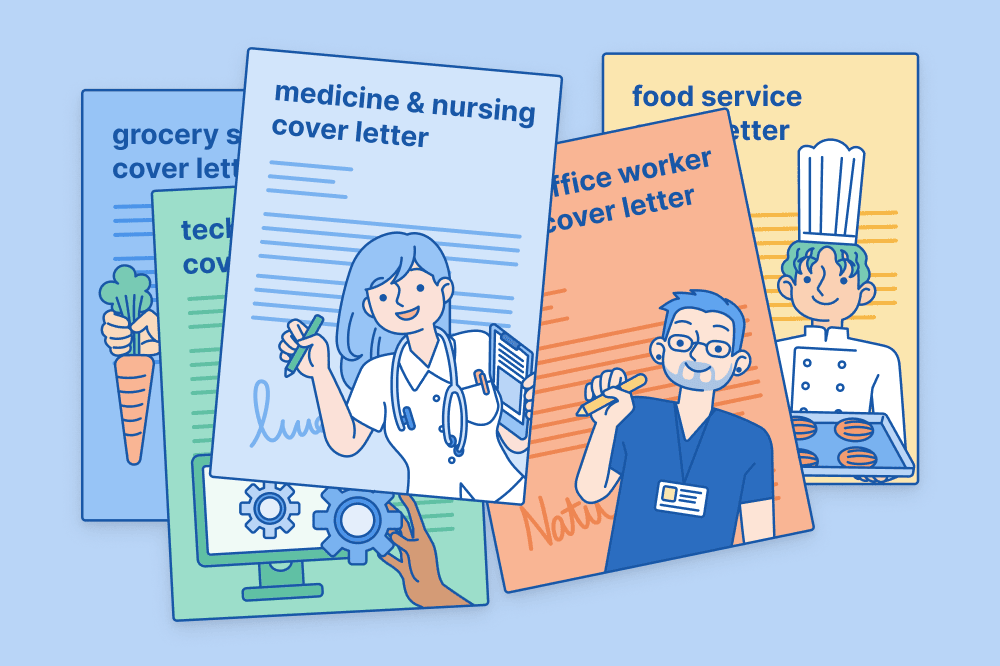
Cover Letter Help

Conrad Benz
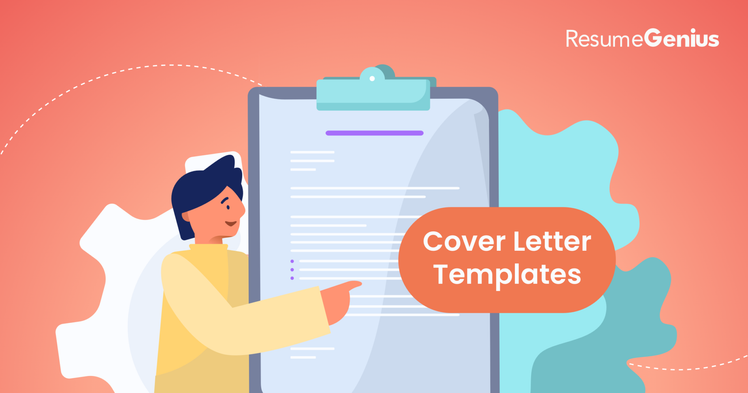
Geoffrey Scott
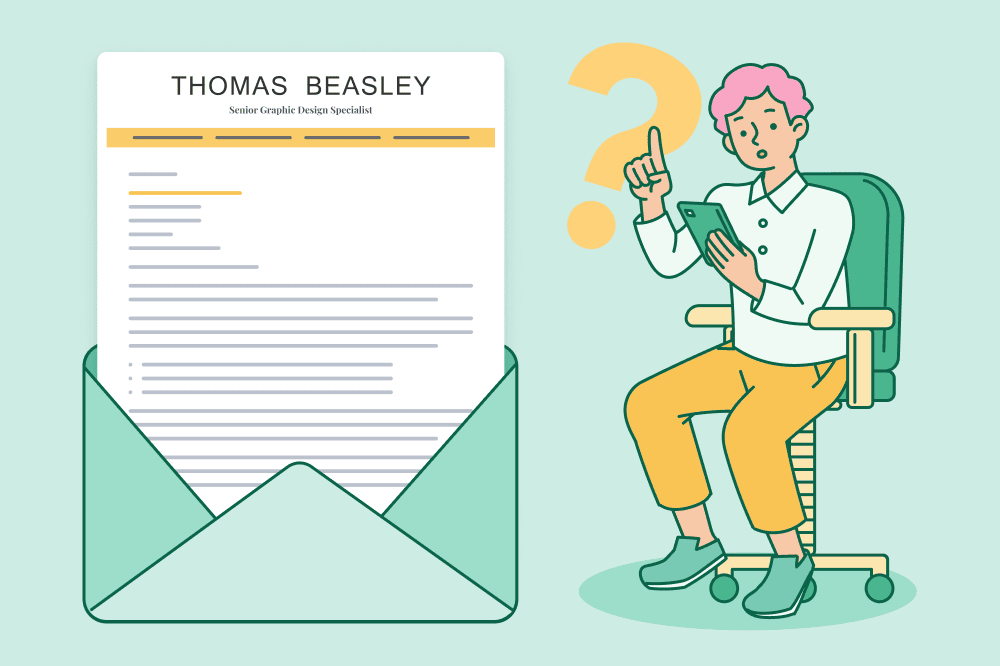
Corissa Peterson
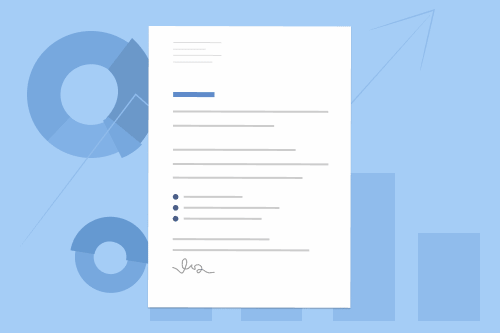
Rebecca Tay, Ph.D.
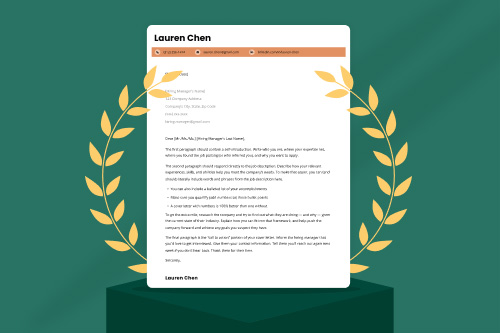
Ida Pettersson
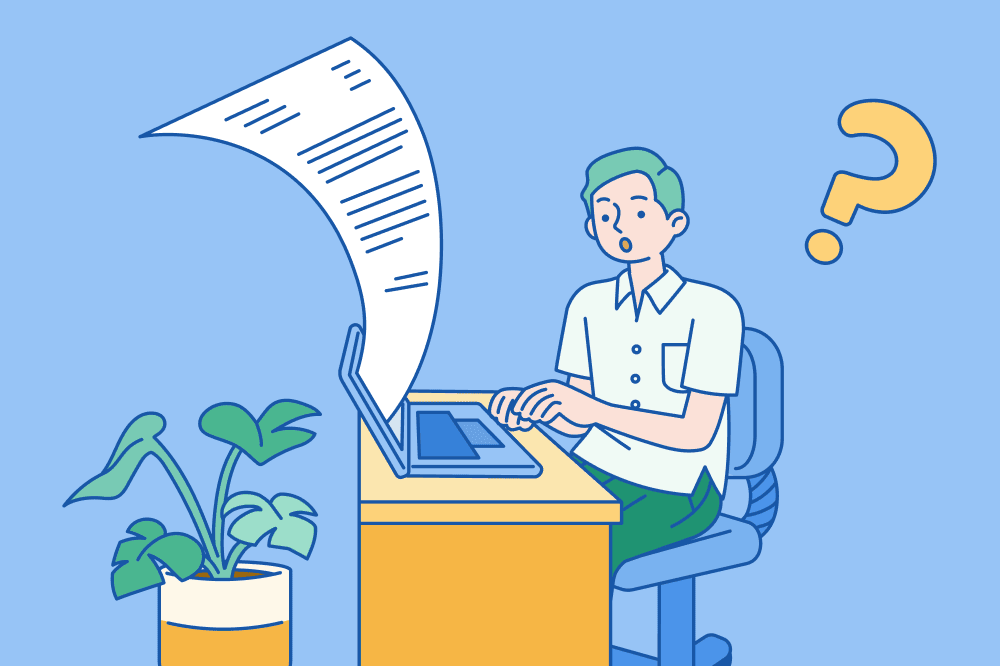
Eva Chan, CPRW
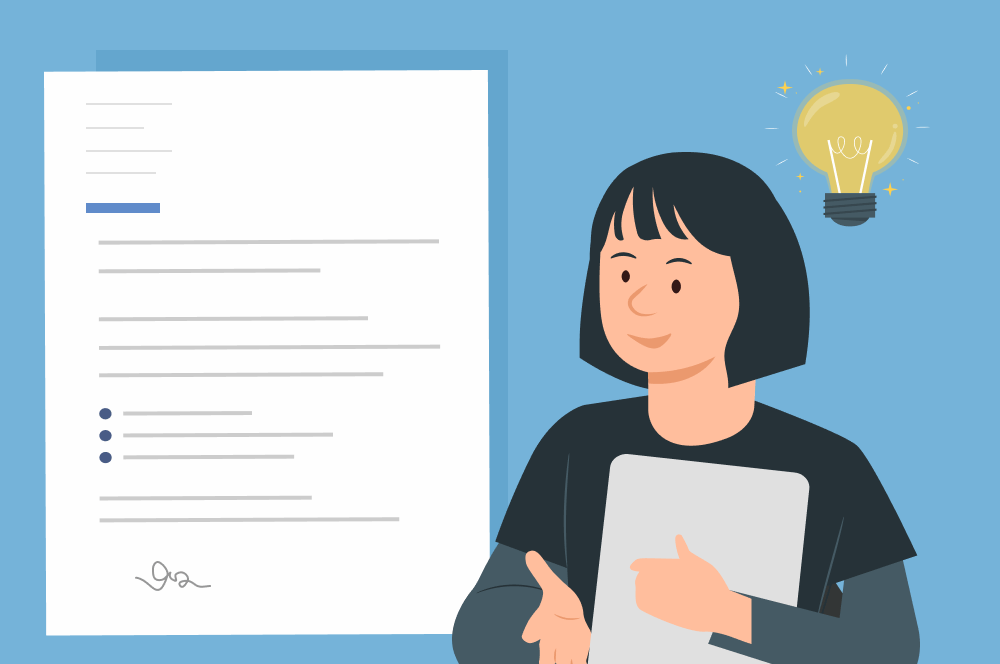
100% FREE TEMPLATES
Use our templates to win the job.
Each template on our website was designed by HR and hiring professionals to help jobseekers easily apply for work.
Sign up for more free templates & career resources!
In addition to this template, you'll also receive:
- Early access to our newest premium templates
- Job-specific resume tips & free examples
- Access to our exclusive newsletter for jobseekers
- Notifications of product improvements
* By sharing your email, you agree to receive marketing emails from our team. You can easily opt out of future emails on the dashboard of your account or by unsubscribing directly from the link at the bottom of an email you receive from us.

IMAGES
VIDEO